
A squid is a mollusc with an elongated soft body, large eyes, eight arms, and two tentacles in the superorder Decapodiformes, though many other molluscs within the broader Neocoleoidea are also called squid despite not strictly fitting these criteria. Like all other cephalopods, squid have a distinct head, bilateral symmetry, and a mantle. They are mainly soft-bodied, like octopuses, but have a small internal skeleton in the form of a rod-like gladius or pen, made of chitin.

A cephalopod is any member of the molluscan class Cephalopoda such as a squid, octopus, cuttlefish, or nautilus. These exclusively marine animals are characterized by bilateral body symmetry, a prominent head, and a set of arms or tentacles modified from the primitive molluscan foot. Fishers sometimes call cephalopods "inkfish", referring to their common ability to squirt ink. The study of cephalopods is a branch of malacology known as teuthology.
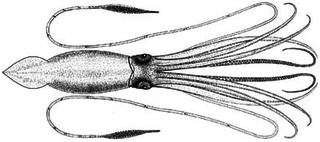
The giant squid is a species of deep-ocean dwelling squid in the family Architeuthidae. It can grow to a tremendous size, offering an example of abyssal gigantism: recent estimates put the maximum size at around 12–13 m (39–43 ft) for females and 10 m (33 ft) for males, from the posterior fins to the tip of the two long tentacles. The mantle of the giant squid is about 2 m long, and the length of the squid excluding its tentacles rarely exceeds 5 m (16 ft). Claims of specimens measuring 20 m (66 ft) or more have not been scientifically documented.

Spirula spirula is a species of deep-water squid-like cephalopod mollusk. It is the only extant member of the genus Spirula, the family Spirulidae, and the order Spirulida. Because of the shape of its internal shell, it is commonly known as the ram's horn squid or the little post horn squid. Because the live animal has a light-emitting organ, it is also sometimes known as the tail-light squid.
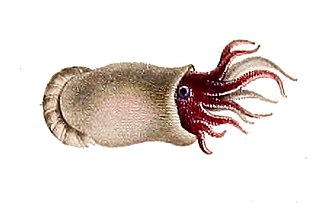
Spirulida is an order of cephalopods comprising one extant species and several extinct taxa.

Coleoidea or Dibranchiata, is one of the two subclasses of cephalopods, containing all the various taxa popularly thought of as "soft-bodied" or "shell-less". Unlike its extant sister group Nautiloidea, whose members have a rigid outer shell for protection, the coleoids have at most an internal shell called cuttlebone or gladius that is used for buoyancy or as muscle anchorage. Some species, notably incirrate octopuses, have lost their cuttlebone altogether, while in some it has been replaced by a chitinous support structure. A unique trait of the group is the ability to edit their own RNA.

Bathyteuthis is the singular genus of squid in the family Bathyteuthidae, encompassing three species.

Myopsida is one of the four orders of squid. It consists of two families: the monotypic Australiteuthis and the diverse and commercially important Loliginidae. Some taxonomists classify this taxon as a suborder of the order Teuthida, in which case it is known as Myopsina. This reclassification is due to Myopsina and Oegopsina not being demonstrated to form a clade.
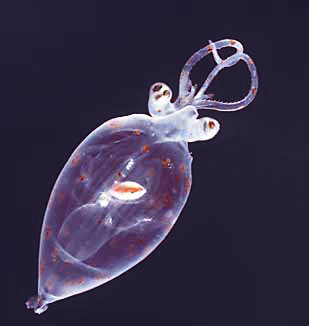
Decapodiformes is a superorder of Cephalopoda comprising all cephalopod species with ten limbs, specifically eight short arms and two long tentacles. It is hypothesized that the ancestral coleoid had five identical pairs of limbs, and that one branch of descendants evolved a modified arm pair IV to become the Decapodiformes, while another branch of descendants evolved and then eventually lost its arm pair II, becoming the Octopodiformes.

Cirrina or Cirrata is a suborder and one of the two main divisions of octopuses. Cirrate octopuses have a small, internal shell and two fins on their head, while their sister suborder Incirrina has neither. The fins of cirrate octopods are associated with a unique cartilage-like shell in a shell sac. In cross-section, the fins have distinct proximal and distal regions, both of which are covered by a thin surface sheath of muscle.
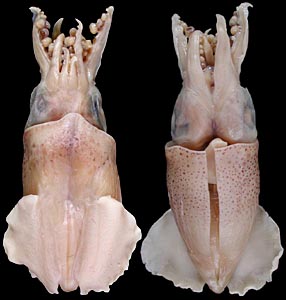
A. aldrichi is a small species of squid found in northern Australian waters. The species was described by Chung Cheng Lu in 2005 based on specimens collected in the inshore waters of Northern Australia. The largest known individual of this species is a mature female measuring 27.6 mm (1.09 in) in mantle length (ML). The holotype is a mature male of 21.3 mm (0.84 in) ML. A live specimen of A. aldrichi has yet to be recorded. A. aldrichi is a member of the class Cephalopoda and part of the subclass Coleodia. Within this class there are two orders, the Myopsida and Oegopsida, which both fall under the superorder Decapodiformes. A. aldrichi falls under the order of Myospida, and is the only member of its genus, Australiteuthis, and family, Australiteuthidae.

Rossia palpebrosa, also known as the warty bobtail squid, is a species of bobtail squid native to the northern Atlantic Ocean.

Xipholeptos is a genus of squid in the family Idiosepiidae. It is monotypic, being represented by the single species Xipholeptos notoides, commonly known as the southern pygmy squid. The species was originally classified as Idiosepius notoides. The southern pygmy squid is native to the southwestern Pacific Ocean, off southern and eastern Australia. It inhabits shallow, inshore waters. It has been recorded off the coasts of New South Wales, South Australia, Tasmania and Victoria.

All cephalopods possess flexible limbs extending from their heads and surrounding their beaks. These appendages, which function as muscular hydrostats, have been variously termed arms, legs or tentacles.
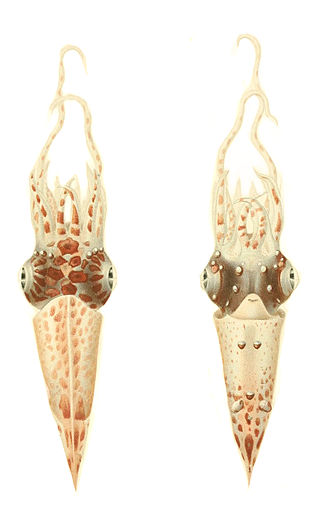
Pterygioteuthis giardi is a species of squid in the family Pyroteuthidae. It is known as the roundear enope squid. The specific name honors the French zoologist and marine biologist Alfred Mathieu Giard (1846-1908).

Sepioloidea pacifica, also known as the Pacific bobtail squid, is a species of cuttlefish native to the southern Pacific Ocean; it occurs off New Zealand in the west and in the Nazca and Sala y Gomez submarine ridges in the east.

Neocoleoidea is a large group of marine cephalopods. This cohort contains two extant groups: Decapodiformes and Octopodiformes. Species within this group exist in all major habitats in the ocean, in both the southern and northern polar regions, and from intertidal zones to great depths. Whilst conventionally held to be monophyletic, the only morphological character for the group is the presence of suckers: although the presence of these features in the belemnites suggests that they do not support the Neocoleoidea, and hence that the group may be paraphyletic.

Bathyteuthida is an order of cephalopods, consisting of small, mesopelagic to bathypelagic squid that in some ways resemble myopsid squid, such as Loligo and in others the pelagic oegopsid squid. Its two families, the Bathyteuthidae and Chtenopterygidae, each containing a single genus, have previously been included with the oegopsids.
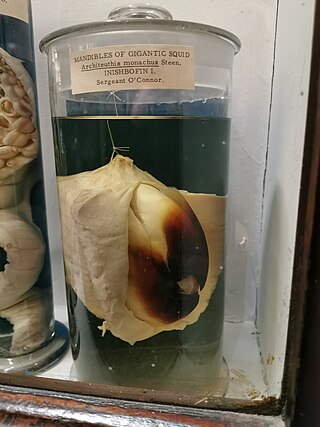
All extant cephalopods have a two-part beak, or rostrum, situated in the buccal mass and surrounded by the muscular head appendages. The dorsal (upper) mandible fits into the ventral (lower) mandible and together they function in a scissor-like fashion. The beak may also be referred to as the mandibles or jaws.
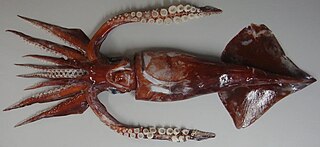
The Antarctic flying squid is a species of squid from the subfamily Todarodinae of the family Ommastrephidae, a family of pelagic squid from the order Oegopsida. It has a circumglobal distribution in the seas around the lower latitudes of the Southern Ocean.




















